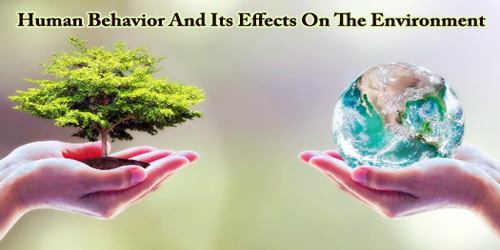Introduction:
For several centuries, the environment has provided habitation for humans and numerous organism but the insatiable needs of humans have driven them to devise strategies for survival and adaptation. Several of these strategies, especially technology, have had direct and indirect negative consequences on the immediate environment, resulting in the degradation of the latter. Many of today’s environmental problems are increasingly the outcomes of individual actions, personal consumer decisions, and the activities of small and large businesses. Nevertheless, the fact remains that the healthiness of the world’s economy and people is inextricably bound to the wellbeing of the environment. This implies that now, much more than previously, there is a greater need to understand patterns, connections, systems, and root causes of the degrading environment. A very strong tool for nipping the 21st-century environmental problems, which are becoming a lot more alarming in the bud, is environmental education. One veritable tool for achieving this feat is a proper understanding and the application of behavioral models and theories.
Human behavior can negatively or positively affect the environment. Environmental settings such as pollution, crowding, heat, water, or noise may be a source of that can negatively impact environmental quality and conditions. Our daily routines have a huge impact on the environment and we do not realize it. New laws that are passing and educating people will help a lot. People are being educated on how to use less water, use our cars less, how to use less energy, and even taking reusable bags when going grocery shopping because plastic bags are very bad for the environment. There are simple solutions that can help in getting started with these efforts. Every little step and effort we make in our daily routines count.
Relationship between the environment and human behavior:
Environmental psychologists study this question in particular, by seeking to understand how the physical environment affects our behavior and well-being, and how our behavior affects the environment. For example, pollution, a component of the physical environment, absolutely can affect our well-being and health. Ozone pollution can have unfavorable effects on humans including shortness of breath, coughing, damage to the airways, damaging the lungs, and making lungs more susceptible to infection (U.S. Environmental Protection Agency (EPA), 2016).
Meanwhile, we taking action to recycle affect the quality of our environment. Recycling and using recycled products saves a substantial amount of energy considering it takes less energy to recycle products than it would to create new materials entirely. In turn, the action of recycling helps battle climate change, one of the biggest threats our planet faces.
Positive Effects of Human Behavior on Environment:
When people do something environmentally friendly, the environmental condition improves. For example, many cultured, educated, and environment-friendly persons, N.G.O.s, and governmental organizations take active steps to improve the environment by reducing and preventing environmental pollution.
Pro-environmental behavior can not only reduce environmental pollution but also reverse the process of environmental pollution in a constructive and positive manner. It can also stop the abuse of the environment.
Observation of pro-environmental weeks, awareness among people to keep the environment free from pollution, active check on deforestation, and plantation of trees and plants on a regular basis by the public, private, government and non-government bodies can bring positive effect on the environment.
Adverse Effects of Human behavior on Environment:
Human behavior can either make or break, protect or destroy his environment. Man grows in the environment and lives in the environment. It is just like a mother to him. But many a times be tries to destroy his own mother i.e., his environment either due to lack of knowledge and awareness or due to ignorance. Sometimes people destroy the environment for their own selfish interest, through deforestation, due to laziness like throwing garbages here and there, instead of putting it in the dustbin.
Many industrialists start industries without taking steps to protect the environment. They even show a “dam care” attitude in this regard. When aggrieved people complain about it they show callous attitude. Only when people file a P.I.L (Public interest litigation) in the court of law, they take some action. Though personal behavior of a single individual like driving an old car, throwing garbage at unwanted place, etc. contribute very little to environment pollution when such behavior of many people are added up, the problem of environment pollution gets multiplied and severely affects human life.
However, recent evidence shows climate change is occurring too drastically to be solely explained through natural means. Humans have made remarkable advancements in technology by creating more automobiles, machines, factories, etc. But this revolution is not all positive. We have seen a rapid increase in greenhouse gas emissions over the last century. Sources of greenhouse gasses include automobiles, planes, factory farming and agriculture, electricity, and industrial production. The issue with greenhouse gasses is that they absorb and emit heat. Abundant greenhouse gases in our atmosphere include carbon dioxide, methane, nitrous oxide, and fluorinated gases (EPA, 2017). When there are large quantities of greenhouse gasses in the atmosphere, the planet is going to get gradually warmer.
Environmental pollution makes people diseased, psychosomatic, and mentally ill. Many people even do not know the consequences and bad impact of their negative behavior towards environmental protection. They perhaps do not know that such small mistakes on their part threaten and destroy their own existence on this planet. We must understand that conservation of water and energy is necessary for living.
Results of climate change:
Believe it or not, we are already experiencing some very damaging effects of climate change. Heatwaves, floods, droughts, wildfires, and loss of sea ice just to name a few (National Aeronautics and Space Administration (NASA), 2017). Scientists predict we will begin to experience even more harmful effects of climate change in the future. At the current rate we are going, the Arctic sea ice is expected to disappear entirely by the end of the century. The current effects we are seeing are also expected to intensify. An even greater problem is the fact that plants and animals are unable to adapt to the quickly changing environment, and are dying off. As a result of climate change, animals’ habitats are becoming completely inhabitable. We are seeing a rapid loss of species which will inevitably affect the natural flow of the biosphere and the individual ecosystems it is composed of.
Due to pollution growth; overconsumption and lack of resource conservation the environment is affected adversely. Because of our present way of living and behaving, harmful changes are taking place in the environment.
Therefore considerable changes are required in our cultural practices and style of living. To overcome this serious threat, we have to live in a simple manner. For example, instead of using sprays while taking a bath, we have to be satisfied simply with water. Instead of using Air-Conditioners, Fans, and Refrigerators which consume a lot of energy, we have to follow the old way of living. We have to make the best use of the environment through conservation, recycling, and disciplined and simple living.
Information Sources:
















